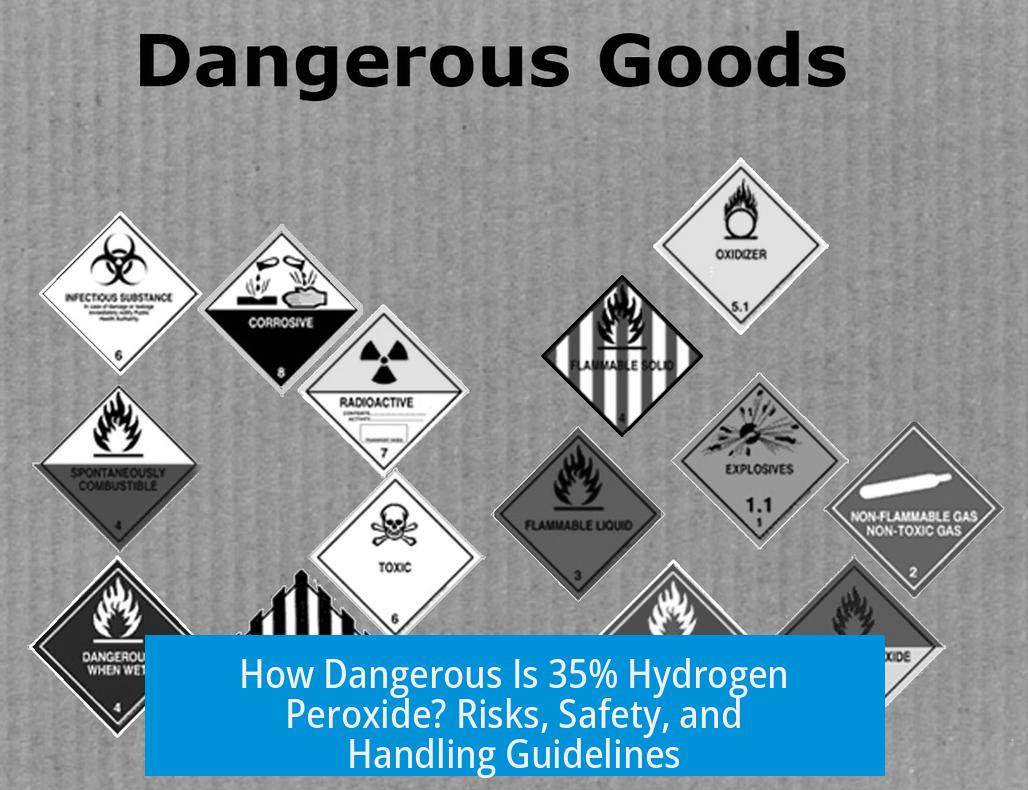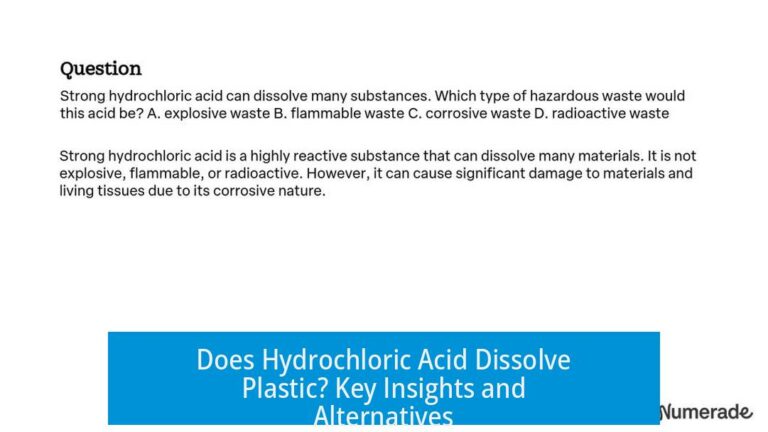How Dangerous Is 35% Hydrogen Peroxide?
35% hydrogen peroxide is a hazardous chemical that poses significant risks due to its strong oxidizing properties, potential for spontaneous decomposition, and harmful effects upon skin, eye, and respiratory exposure. While it is not explosive at this concentration, it requires careful handling, proper storage, and safety precautions to prevent accidents, injuries, and environmental harm.
Chemical Stability and Decomposition Risks
Hydrogen peroxide (H2O2) decomposes naturally into water (H2O) and oxygen gas (O2), following the reaction: 2H2O2 → 2H2O + O2. This process accelerates as water content decreases, such as when a spill dries. At 35%, the solution is concentrated enough to be unstable if not properly managed.
Storage in vented containers is essential because oxygen builds up as peroxide breaks down. Without ventilation, pressure can increase inside sealed bottles, causing ruptures or bursts. Factors like the presence of metals, especially iron, catalyze decomposition and increase the risk of rapid oxygen release. This catalytic effect can lead to sudden gas evolution, pressure spikes, and even explosive events in confined spaces.
Stabilizers are sometimes added to lower-grade peroxide to slow decomposition, but industrial-grade or high-purity 35% solutions may lack these inhibitors and can degrade over time on storage shelves. This instability creates a constant risk if peroxide is not frequently checked, stored correctly, or handled with caution.
Oxidizer and Explosion Hazards
Although hydrogen peroxide is a powerful oxidizer, solutions below approximately 70% concentration rarely explode on their own. At 35%, it does not pose a high explosion hazard solely by itself. However, it is classified as an oxidizer under hazardous materials regulations.
This classification means it can intensify fires or react dangerously with combustible materials or reducing agents. Contact with flammable solvents, oils, or contaminants can trigger violent reactions. Its oxidizing potential necessitates careful compatibility considerations during storage and use.
Container quality also influences safety. Thin-walled, non-vented plastic bottles are inappropriate for 35% peroxide as they cannot withstand pressure buildup. Such packaging may violate transport and safety regulations, increasing the chances of container failure during shipping or storage.
Health Hazards from Skin and Eye Contact
Skin Exposure
Hydrogen peroxide at 35% can damage skin on contact without immediate but intense corrosion. It may cause blanching (turning the skin white) and irritation resembling severe dryness. Prolonged or repeated exposure can result in burns. Temporary capillary embolism, characterized by small blood vessel blockages, may occur but typically resolves.
Clothing contaminated with 35% peroxide should be rinsed immediately as the chemical can degrade fabric and prolong skin exposure. Gloves and protective clothing are necessary to minimize direct contact during handling.
Eye Exposure
Eye contact with 35% hydrogen peroxide represents a serious hazard. It can produce rapid corneal burns that require immediate and extensive rinsing. Medical intervention is critical to prevent lasting damage or vision loss. Even small splashes can cause significant injury, underscoring the importance of eye protection.
Inhalation and Environmental Risks
Inhalation of hydrogen peroxide vapors at significant concentrations may irritate the respiratory tract. The NIOSH Immediately Dangerous to Life or Health (IDLH) limit for hydrogen peroxide is 75 ppm, which can be reached if large volumes are spilled in poorly ventilated areas.
Exposure to concentrated vapor or mist should be avoided. Industrial hygiene practices call for adequate ventilation when working with 35% peroxide. The chemical’s breakdown also releases oxygen, which can exacerbate fire risks in enclosed spaces.
Environmental spills can have localized effects. Hydrogen peroxide breaks down into oxygen and water, but the sudden oxygen release can disturb aquatic and terrestrial habitats.
Safe Handling and Storage Practices
- Always wear gloves, protective eyewear, and appropriate clothing when working with 35% hydrogen peroxide.
- Promptly dilute spills with plenty of water before cleaning with disposable towels.
- Rinse contaminated clothing or skin immediately to reduce injury.
- Store peroxide in vented, pressure-relief containers to prevent dangerous gas buildup.
- Avoid storing near iodides, ammonia, metals, flammable solvents, oils, greases, heat, and direct light.
- Ensure containers are robust, compliant with shipping and safety regulations, and checked regularly for pressure or degradation.
- Maintain clear labeling and have Material Safety Data Sheets (MSDS) accessible for all handlers.
- Work in well-ventilated areas to control inhalation exposure.
Regulatory Considerations and Safety Data
35% hydrogen peroxide qualifies as an oxidizer hazardous material under transport and workplace safety regulations. It demands stringent labeling and packaging controls. The NIOSH IDLH exposure limit of 75 ppm should guide ventilation and air monitoring standards.
Material Safety Data Sheets, such as the [one provided by VWR](https://us.vwr.com/stibo/hi_res/BDH8814-3.pdf), offer detailed chemical and safety information. Employers must ensure compliance with local, state, and federal Occupational Health and Safety guidelines.
Risks of Misuse and Medical Dangers
Ingesting or injecting 35% hydrogen peroxide is extremely hazardous and medically unsound. There have been cases of fatal outcomes from people attempting ingestion or intravenous use, leading to severe embolisms and tissue damage.
The Food and Drug Administration (FDA) only permits diluted hydrogen peroxide (around 3%) for limited uses like mouthwash after further dilution. Concentrations above 5% are restricted or banned in many jurisdictions due to misuse potential and safety risks.
Users should never consume or inject hydrogen peroxide, especially at 35% concentration, as this can cause irreversible harm or death.
Packaging and Shipping Concerns
Transporting 35% hydrogen peroxide requires proper containers designed to withstand pressure from oxygen buildup. Thin, non-vented plastic bottles sometimes used in shipping can rupture or leak, breaching Department of Transportation (DOT) and shipping regulations.
To mitigate risks, robust, vented, and certified bottles must be used. Incorrect packaging not only threatens handlers’ safety but also causes product loss and environmental hazards.
Key Takeaways
- 35% hydrogen peroxide is a strong oxidizer with instability hazards due to spontaneous oxygen release.
- It is moderately corrosive to skin and eyes and can cause burns and permanent eye damage.
- Proper personal protective equipment and ventilation are essential for safe use.
- Storage requires vented, durable containers away from incompatible substances.
- Misuse by ingestion or injection is highly dangerous and medically prohibited.
- Compliance with regulatory standards for transport, storage, and exposure limits minimizes risk.
- Spills must be promptly diluted and cleaned to prevent decomposition hazards and environmental impact.
What makes 35% hydrogen peroxide unstable and potentially dangerous?
It decomposes into water and oxygen gas naturally. This speeds up if exposed to heat, light, metals, or iodide. Oxygen buildup can cause pressure in containers, risking rupture or explosion.
Can 35% hydrogen peroxide cause skin or eye injuries?
Yes. It can cause burns or whitening on skin and severe corneal burns if it gets in your eyes. Immediate washing and medical help are needed for eye exposure.
Is 35% hydrogen peroxide explosive on its own?
No, it is not likely to explode alone below about 70%. But as a strong oxidizer, it can intensify fires and must be stored carefully in vented, secure containers.
How should spills of 35% hydrogen peroxide be handled safely?
Dilute the spill with lots of water. Then mop it up carefully while wearing gloves. Dispose of contaminated materials safely to avoid skin contact or inhalation.
Why is inhaling 35% hydrogen peroxide vapors a concern?
Breathing vapors above 75 ppm can be harmful. Large spills in unventilated spaces increase inhalation risks, which may cause respiratory irritation or worse health effects.





Leave a Comment